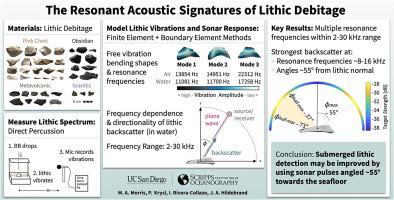Journal of Archaeological Science: Reports Pub Date : 2021-12-07 , DOI: 10.1016/j.jasrep.2021.103266 Margaret A. Morris 1 , Petr Krysl 2 , Isabel C. Rivera-Collazo 1, 3 , John A. Hildebrand 1

|
Acoustic methods to search for submerged archaeological sites have shown that concentrations of knapped flint produce a visible acoustic response in chirp sonar profiles in a variety of geographical settings. Field tests and simulations have suggested that the submerged lithic signal is due to acoustic resonances of the flaked stone. We model and measure the resonant acoustic signatures of chert, obsidian, metavolcanic, and granitic lithic debitage. Struck lithics produce multiple resonant peaks under 30 kHz, with high quality factors that decrease with material coarseness. We use a combination of the finite element and boundary element methods to model the natural vibrations of lithic debitage in both air and water. Direct measurement of lithic material density and adjustment of the Young’s modulus and Poisson’s ratio provide excellent correspondence between measured and modeled resonances. Using a coupled finite element and boundary integral method, we model the acoustic scattering return of individual lithics in water as a function of frequency and incidence angle. We find the strongest resonant signal between 8 and 16 kHz for a collection of lithic debitage. Results indicate that the lithic resonance signal is highly directional, with target strength up to −20 dB when excited at optimal angles. For a flat-laying lithic, target strength at normal incidence is, on average, 10 dB lower than the strongest signal, typically found from normal incidence. We suggest that the best way to detect submerged lithics may not be through standard mono-static sub-bottom profiling with a direct downward pulse, but with a chirp pulse sent and received at an angle with respect to the sea bottom.
中文翻译:

石质借方的共振声学特征
搜索水下考古遗址的声学方法表明,在各种地理环境中,碎石的浓度会在啁啾声纳剖面中产生可见的声学响应。现场测试和模拟表明,淹没的岩屑信号是由于薄片石头的声学共振引起的。我们模拟并测量燧石、黑曜石、变质火山和花岗质岩屑沉积物的共振声学特征。撞击石料在 30 kHz 以下产生多个共振峰,具有随材料粗糙度降低的高质量因子。我们结合使用有限元和边界元方法来模拟空气和水中岩屑沉积的自然振动。直接测量石料密度和调整杨氏模量和泊松比,在测量和模拟共振之间提供了极好的对应关系。使用耦合的有限元和边界积分方法,我们将水中单个岩屑的声学散射返回建模为频率和入射角的函数。我们发现 8 到 16 kHz 之间的最强共振信号用于收集石块。结果表明,当以最佳角度激发时,岩石共振信号具有高度定向性,目标强度高达 -20 dB。对于平铺的石块,垂直入射时的目标强度平均比通常发现的最强信号低 10 dB 我们将水中单个石块的声学散射返回建模为频率和入射角的函数。我们发现 8 到 16 kHz 之间的最强共振信号用于收集石块。结果表明,当以最佳角度激发时,岩石共振信号具有高度定向性,目标强度高达 -20 dB。对于平铺的石块,垂直入射时的目标强度平均比通常发现的最强信号低 10 dB 我们将水中单个石块的声学散射返回建模为频率和入射角的函数。我们发现 8 到 16 kHz 之间的最强共振信号用于收集石块。结果表明,当以最佳角度激发时,岩石共振信号具有高度定向性,目标强度高达 -20 dB。对于平铺的石块,垂直入射时的目标强度平均比通常发现的最强信号低 10 dB从正常发病率来看。我们建议检测水下岩屑的最佳方法可能不是通过标准的单静态海底剖面分析,使用直接向下的脉冲,而是使用与海底成一定角度发送和接收的啁啾脉冲。



























 京公网安备 11010802027423号
京公网安备 11010802027423号